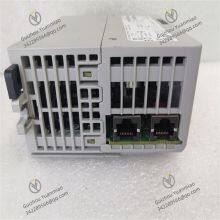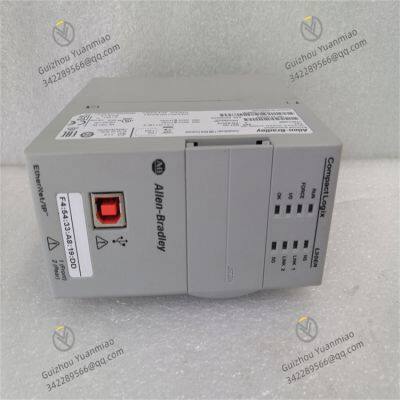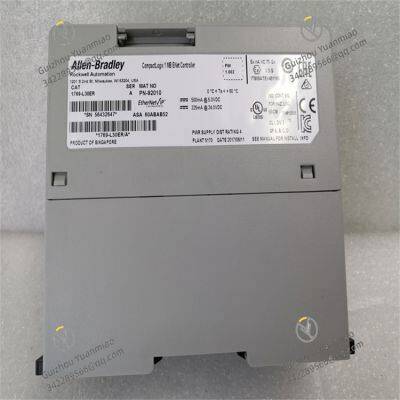I. Product Overview
Rockwell Automation 1769-L30ER is a high-performance Programmable Logic Controller (PLC) in the CompactLogix series, mainly targeting small-to-medium and medium-sized industrial automation control scenarios. As the core of the control system, it features excellent data processing capabilities, stable communication functions, and flexible expansion performance. It can efficiently integrate various on-site signals, generate control instructions through precise logical operations, and realize reliable regulation of industrial production processes. The controller adopts a modular design, highly compatible with 1769 series I/O modules, communication modules, etc. It can build adaptive automation systems according to actual needs and is widely used in fields such as machinery manufacturing, food processing, warehousing and logistics, and municipal engineering, providing strong control guarantees for the stable and efficient operation of industrial production.

II. Performance Parameters
Processor and Memory: Equipped with a high-performance processor, it has a fast operation speed and can smoothly handle control logic of medium complexity and real-time data. The memory configuration is reasonable: the program memory can meet the storage needs of small-to-medium control programs, and the data memory can provide sufficient space for real-time data, intermediate variables, etc., ensuring the stable operation of the system under normal loads.
Power Parameters: It uses 24V DC power supply, with a certain adaptability in the power input range. It can usually work stably within the range of 19.2-30V DC and has strong resistance to voltage fluctuations. The power circuit adopts filtering and anti-interference technologies, which can effectively resist electromagnetic interference and voltage shocks in the industrial environment, ensuring the continuous and stable operation of the controller.
I/O Module Support: It supports expanding a certain number of 1769 series I/O modules (the specific number depends on the module power consumption) and is compatible with conventional modules such as digital and analog modules. It can meet the basic needs of signal acquisition and control output in small-to-medium industrial control scenarios and is suitable for connecting various industrial equipment.
Communication Interfaces: It integrates an EtherNet/IP interface, supporting data communication with human-machine interfaces (HMI), other controllers, remote I/O modules, etc., with a communication rate of up to 100Mbps, realizing efficient data interaction between devices. Some models may be equipped with RS-232 or RS-485 serial interfaces, facilitating on-site debugging and connecting specific peripheral devices.
Storage Function: It has a built-in non-volatile memory that can permanently store user programs, configuration parameters, and key data. Data will not be lost after power failure, ensuring that the system can quickly resume normal operation after restart. It supports program backup, data storage, and system upgrade through CompactFlash cards, improving the convenience of system maintenance.
Environmental Parameters:
Operating Temperature: It can work stably within the temperature range of 0℃-60℃, adapting to temperature changes in common environments such as industrial production workshops and control cabinets, with no significant impact on performance.
Relative Humidity: It can operate normally in a relative humidity environment of 5%-95% (non-condensing), coping with humid industrial places and effectively preventing circuit faults caused by humidity.
Anti-electromagnetic Interference: It complies with industrial electromagnetic compatibility standards, has a certain anti-electromagnetic interference capability, and can resist electromagnetic interference generated by conventional equipment in industrial sites, ensuring the accurate execution of control instructions and the stability of data transmission.
Vibration and Shock Resistance: It has certain vibration and shock resistance. The vibration resistance range is 10-500Hz, with an amplitude of 0.38mm or an acceleration of 10g; the shock resistance range is generally 15g (11ms). It can withstand vibration and shock generated during the operation of industrial on-site equipment, ensuring the stability of the controller's structure and performance.

III. Functional Features
Reliable Control Capability: It supports multiple programming languages such as ladder diagram, Structured Text (ST), and Function Block Diagram (FBD), facilitating engineers to develop programs according to different control needs. It has a rich set of instructions, including common instructions such as logical operations, arithmetic operations, timers, counters, and PID control, which can realize control logic of medium complexity and meet the needs of small-to-medium industrial control tasks.
Real-time Data Processing: Adopting a real-time operating system, it can quickly respond to external events and input signals, ensuring the real-time performance of control tasks. It timely processes and analyzes the collected on-site data, quickly updates the system status, and responds according to the control logic, ensuring the synchronization and accuracy of the industrial production process.
Flexible Expansion Capability: Based on the modular architecture of the CompactLogix series, it can increase the number of I/O points and functional modules through rack expansion or remote I/O, easily coping with changes in control needs brought about by expanded production scale or process adjustments, without replacing the main controller, thus reducing system upgrade costs.
Stable Communication Function: It realizes stable communication with other devices through the EtherNet/IP interface, supports the CIP protocol, and can realize functions such as data sharing, remote monitoring, and equipment diagnosis. It can be integrated with Rockwell Automation's related software systems to build a complete industrial automation information system, realizing data interaction from on-site control to management.
Practical Diagnosis and Maintenance Functions: It has basic self-diagnosis functions, which can monitor the operating status of the controller itself and the connected modules in real-time, such as power failure and communication abnormalities, and issue fault alarm information through indicators, communication interfaces, or HMI, facilitating operators to quickly locate and eliminate faults. It supports online programming and debugging, allowing engineers to modify and test programs without interrupting system operation, improving system maintenance efficiency.
Safe and Reliable Design: It uses industrial-grade components and a robust shell design, with certain dustproof, moisture-proof, and anti-corrosion properties, meeting the requirements of industrial environments. It supports password protection to prevent unauthorized personnel from modifying programs and configuration parameters, ensuring the security and stability of the system.

IV. Application Scenarios
Machinery Manufacturing Production Lines: In small-to-medium machinery processing production lines, 1769-L30ER can serve as the core controller, integrating signals from various sensors (such as position sensors and temperature sensors) and actuators (such as motors and cylinders) to realize automatic control of the production line. For example, it controls the processing actions of machine tools, the running speed of conveying equipment, and the positioning of workpieces, coordinates the working rhythm between various devices, and improves production efficiency and processing accuracy.
Food and Beverage Processing Equipment: In production links such as filling and packaging of food and beverages, the controller can receive signals from liquid level sensors, pressure sensors, photoelectric sensors, etc., control the start/stop of filling equipment and the actions of packaging machines, and automatically adjust production parameters according to preset programs to ensure the consistency of product quality and the hygiene and safety of the production process. At the same time, through communication with HMI, it realizes real-time monitoring of production data and parameter setting, facilitating management by operators.
Warehousing and Logistics Equipment: In small-to-medium automated warehouses and logistics sorting lines, 1769-L30ER can receive signals from barcode scanners, goods location sensors, limit switches, etc., control the operation of conveying lines, sorting mechanisms, and other equipment, and realize automatic conveying and sorting of goods. Through communication with the warehouse management system, it feeds back information on goods storage and circulation in real-time, optimizes logistics scheduling, and improves the operational efficiency of warehousing and logistics.
Municipal Auxiliary Equipment: In municipal auxiliary facilities such as small water treatment equipment and heating systems, the controller can collect signals from sensors such as liquid level, pressure, and temperature, control the operation of water pumps, valves, and other equipment, and realize automatic control and remote monitoring of the equipment. According to preset control logic, it automatically adjusts the operating status of the equipment, improves the operating efficiency of municipal facilities, and reduces labor costs.














































